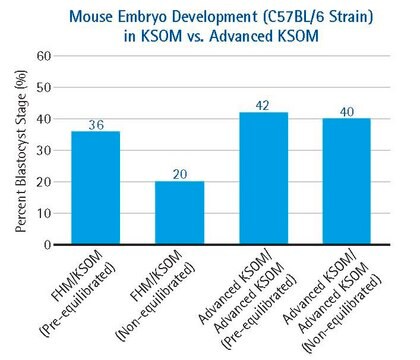MR-024
EmbryoMax® FHM Mouse Embryo Media
(1X), liquid, with Phenol Red
Sign Into View Organizational & Contract Pricing
All Photos(1)
About This Item
UNSPSC Code:
12352207
eCl@ss:
32160801
NACRES:
NA.71
Recommended Products
Quality Level
form
liquid
manufacturer/tradename
Specialty Media
EmbryoMax®
technique(s)
cell culture | embryo: suitable
cell culture | stem cell: suitable
input
sample type: mouse embryo(s)
Related Categories
General description
EmbryoMax® FHM Mouse Embryo Media is used to enable embryo collection, manipulation, and transfer techniques. offers a range of mouse embryo media and reagents for your research needs.
Application
EmbryoMax® FHM Mouse Embryo Media has been used to recover mouse fertilized eggs or embryos from the oviduct.
Storage and Stability
Store at -20°C upto 2 months & 1 day
Note: Our EmbryoMax Liquid Mouse Embryo Media is produced on a bi-monthly basis. For regular users, we encourage standing orders to ensure that backorders do not occur.
Note: Our EmbryoMax Liquid Mouse Embryo Media is produced on a bi-monthly basis. For regular users, we encourage standing orders to ensure that backorders do not occur.
Legal Information
EmbryoMax is a registered trademark of Merck KGaA, Darmstadt, Germany
Storage Class Code
12 - Non Combustible Liquids
WGK
WGK 2
Flash Point(F)
Not applicable
Flash Point(C)
Not applicable
Certificates of Analysis (COA)
Search for Certificates of Analysis (COA) by entering the products Lot/Batch Number. Lot and Batch Numbers can be found on a product’s label following the words ‘Lot’ or ‘Batch’.
Already Own This Product?
Find documentation for the products that you have recently purchased in the Document Library.
Customers Also Viewed
Vernadeth B Alarcon
Biology of reproduction, 83(3), 347-358 (2010-05-28)
In preimplantation mouse development, the first cell lineages to be established are the trophectoderm (TE) and inner cell mass. TE possesses epithelial features, including apical-basal cell polarity and intercellular junctions, which are crucial to generate a fluid-filled cavity in the
A potential use of embryonic stem cell medium for the in vitro culture of preimplantation embryos.
Gelber K. et al.
Journal of Assisted Reproduction and Genetics null
Our team of scientists has experience in all areas of research including Life Science, Material Science, Chemical Synthesis, Chromatography, Analytical and many others.
Contact Technical Service


